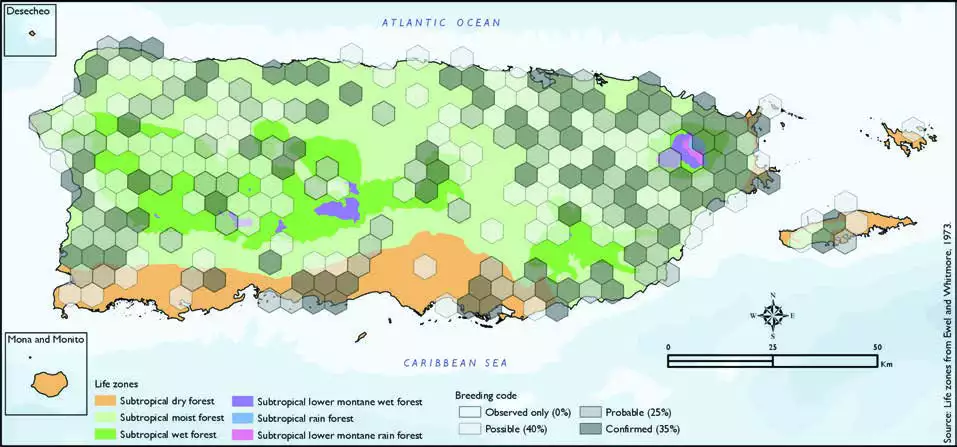Scaly-breasted Munia
Description
The scaly-breasted munia or spotted munia (Lonchura punctulata), known in the pet trade as nutmeg mannikin or spice finch, is a sparrow-sized estrildid finch native to tropical Asia. A species of the genus Lonchura, it was formally described and named by Carl Linnaeus in 1758. Its name is based on the distinct scale-like feather markings on the breast and belly. The adult is brown above and has a dark conical bill. The species has 11 subspecies across its range, which differ slightly in size and color.
Distribution & Habitat
The Scaly-breasted Munia is native from India and
Pakistan to southeastern Asia,
Taiwan, and the Philippines
(Restall 1997), and has been
introduced to Cuba, Jamaica,
the Dominican Republic,
Puerto Rico, and Guadeloupe
(Camacho Rodríguez and others
1999, Raffaele and others 1998).
Introduced to Puerto Rico in
1971 (Raffaele and Kepler 1992),
it is common from Ceiba to Vega
Baja and occurs less frequently
in lowlands throughout the
island. It has also been reported
from Culebra (J.A. Salguero-
Faría, personal observation
2009) and Vieques islands, in the latter being a rare resident
throughout the year (Gemmill
2015). The species usually occurs
in lowland open areas with
grasses, borders of sugarcane
plantations, agricultural areas,
road edges, and parks in urban
areas (Raffaele and others
1998). Atlas fieldwork yielded a
total of 388 records within 247
hexagons or 52 percent of the
479 total hexagons (see map).
Of the hexagons where the
Scaly-breasted Munia was found,
breeding met the atlas definition
of confirmed in 35 percent (86)
of the hexagons, probable in 25
percent (61), and possible in 40
percent (100) (see map). Scaly-breasted Munia distribution. The map shows the highest breeding code by hexagon and overlaying the ecological life zones in
Puerto Rico. Note: percentages may not total 100 due to rounding. 249Scaly-breasted Munia/Gorrión Canela

Breeding Habits
Previously published reports indicate that the Scaly-breasted
Munia breeds primarily from
June to October (Raffaele and
others 1998). Nests are bulky
and dome-shaped, usually
built at a moderate height
in trees (Raffaele and others
1998). Atlas results show that
this species breeding season
extends throughout the year
with the most breeding activity
from March to July (see chart).
The breeding activity peaks in
June after the onset of the rainy
season, and breeding mostly
occurs in the subtropical moist
forest life zone (see chart). Results show that this species
breeds mostly in lowlands within
the subtropical moist forest
life zone (66 percent of the
hexagons) (see table and map).
However, results indicate that it
also breeds at higher elevations
within the subtropical wet forest
life zones (19 percent of the
hexagons), as well as in the
coastal plains of the subtropical
dry forest life zone (15 percent
of the hexagons) (see table
and map).
Conservation
The global population size for the Scaly-breasted Munia has
not been quantified or assessed, but it is described as abundant,
common or locally common
(Clement 1999). This species
is currently listed as a species
of least concern by the IUCN
(BirdLife International 2016).
Locally, this species is not
listed in any of the threatened
categories of PRDNER and
USFWS. In Puerto Rico, the
Scaly-breasted Munia has a
protected habitat in land of
about 10 percent or 620 km2 of the total area covered by
the hexagons where evidence
of breeding was found for this
species (5905 km2).
Related Species
Family:
finch